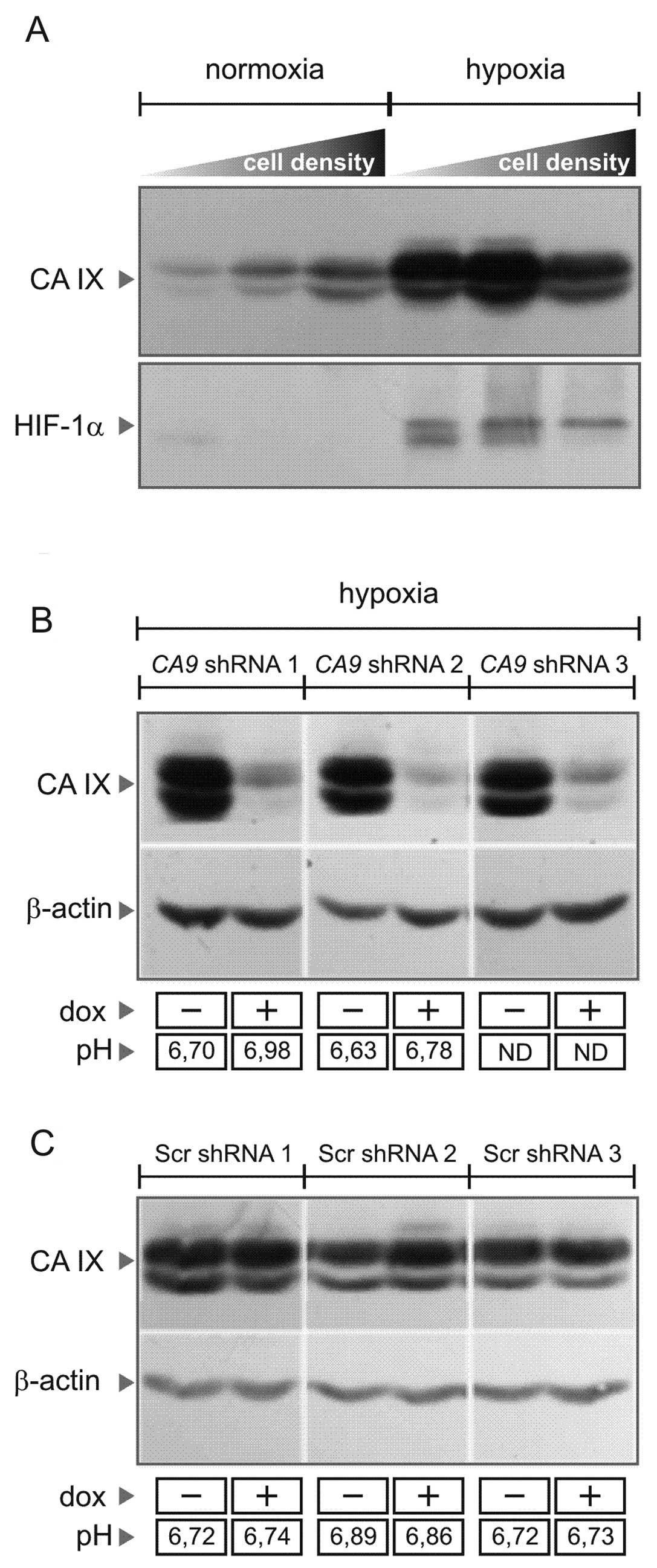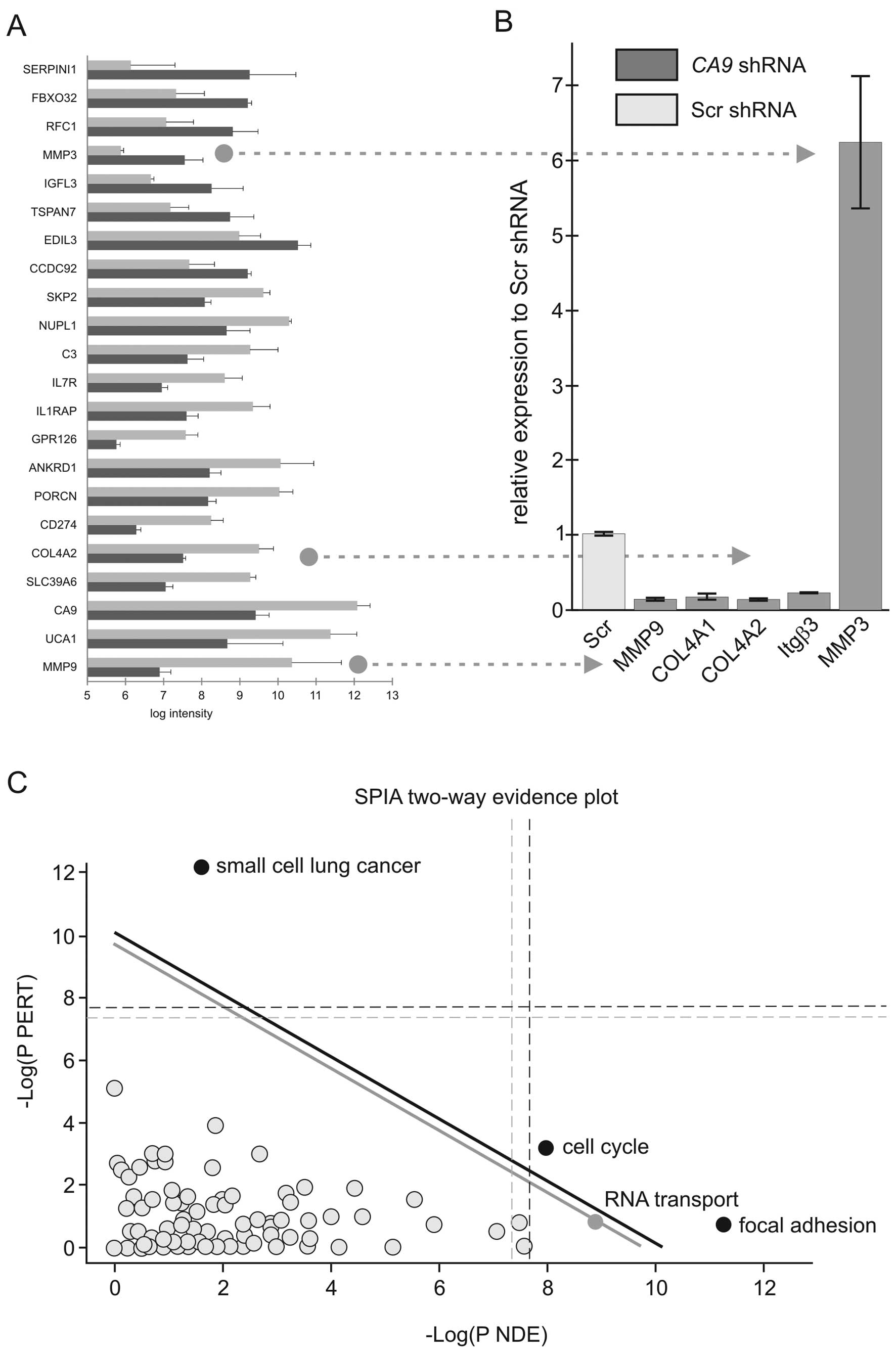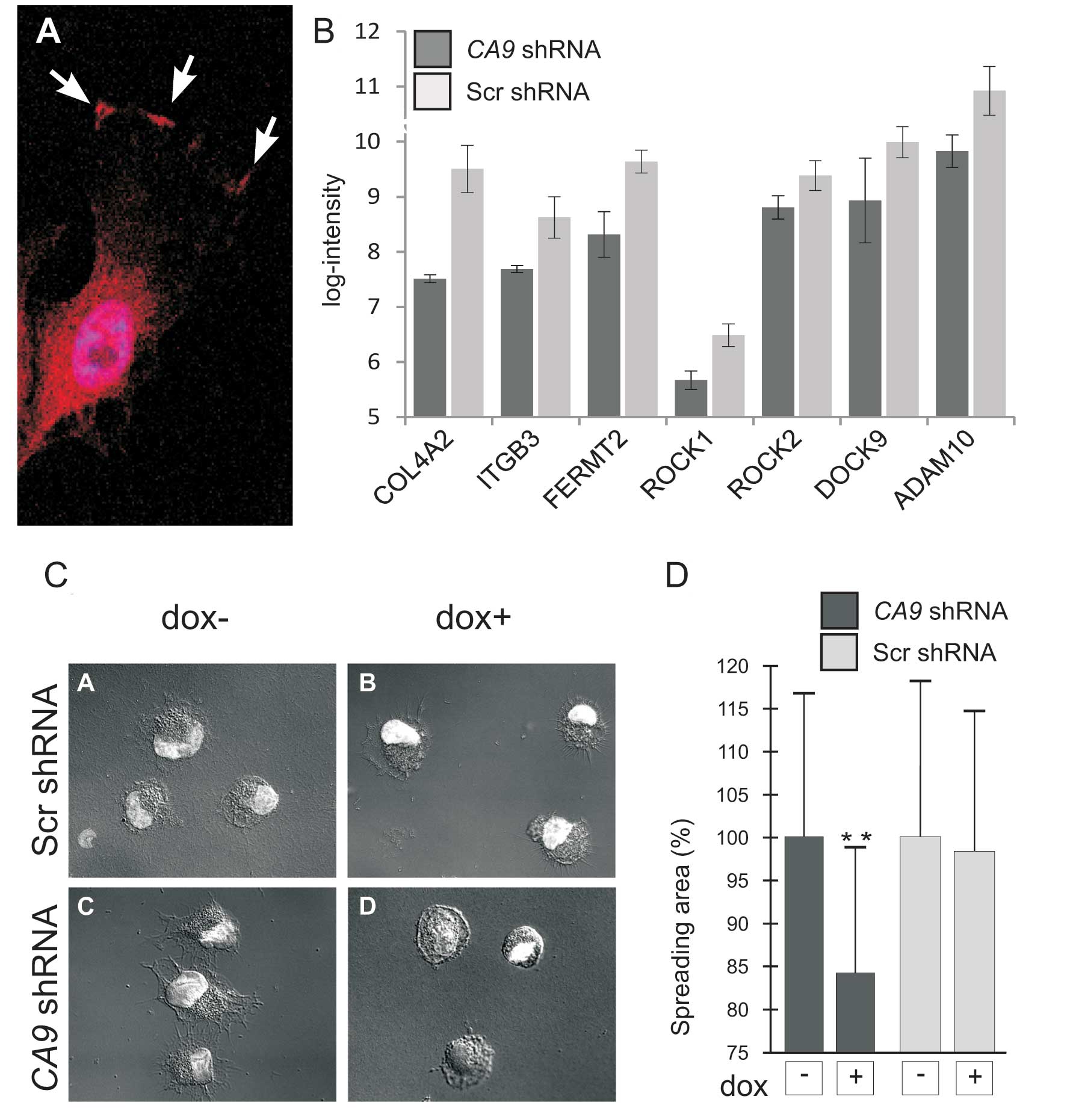|
1
|
Harris AL: Hypoxia - a key regulatory
factor in tumour growth. Nat Rev Cancer. 2:38–47. 2002. View Article : Google Scholar : PubMed/NCBI
|
|
2
|
Pastorekova S, Parkkila S, Pastorek J and
Supuran CT: Carbonic anhydrases: current state of the art,
therapeutic applications and future prospects. J Enzyme Inhib Med
Chem. 19:199–229. 2004.PubMed/NCBI
|
|
3
|
Pastorek J, Pastorekova S, Callebaut I, et
al: Cloning and characterization of MN, a human tumor-associated
protein with a domain homologous to carbonic anhydrase and a
putative helix-loop-helix DNA binding segment. Oncogene.
9:2877–2888. 1994.
|
|
4
|
Wykoff CC, Beasley NJ, Watson PH, et al:
Hypoxia-inducible expression of tumor-associated carbonic
anhydrases. Cancer Res. 60:7075–7083. 2000.PubMed/NCBI
|
|
5
|
Potter C and Harris AL: Hypoxia inducible
carbonic anhydrase IX, marker of tumour hypoxia, survival pathway
and therapy target. Cell Cycle. 3:164–167. 2004. View Article : Google Scholar : PubMed/NCBI
|
|
6
|
Svastova E, Hulikova A, Rafajova M, et al:
Hypoxia activates the capacity of tumor-associated carbonic
anhydrase IX to acidify extracellular pH. FEBS Lett. 577:439–445.
2004. View Article : Google Scholar : PubMed/NCBI
|
|
7
|
Swietach P, Hulikova A, Vaughan-Jones RD
and Harris AL: New insights into the physiological role of carbonic
anhydrase IX in tumour pH regulation. Oncogene. 29:6509–6521. 2010.
View Article : Google Scholar : PubMed/NCBI
|
|
8
|
Raghunand N, Gatenby RA and Gillies RJ:
Microenvironmental and cellular consequences of altered blood flow
in tumours. Br J Radiol. 76(Spec No 1): S11–S22. 2003. View Article : Google Scholar : PubMed/NCBI
|
|
9
|
Svastova E, Zilka N, Zat’ovicova M, et al:
Carbonic anhydrase IX reduces E-cadherin-mediated adhesion of MDCK
cells via interaction with beta-catenin. Exp Cell Res. 290:332–345.
2003. View Article : Google Scholar : PubMed/NCBI
|
|
10
|
Svastova E, Witarski W, Csaderova L, et
al: Carbonic anhydrase IX interacts with bicarbonate transporters
in lamellipodia and increases cell migration via its catalytic
domain. J Biol Chem. 287:3392–3402. 2012. View Article : Google Scholar : PubMed/NCBI
|
|
11
|
Takacova M, Holotnakova T, Barathova M,
Pastorekova S, Kopacek J and Pastorek J: Src induces expression of
carbonic anhydrase IX via hypoxia-inducible factor 1. Oncol Rep.
23:869–874. 2010.PubMed/NCBI
|
|
12
|
Ihnatko R, Kubes M, Takacova M, et al:
Extracellular acidosis elevates carbonic anhydrase IX in human
glioblastoma cells via transcriptional modulation that does not
depend on hypoxia. Int J Oncol. 29:1025–1033. 2006.
|
|
13
|
Kaluz S, Kaluzova M and Stanbridge EJ:
Expression of the hypoxia marker carbonic anhydrase IX is
critically dependent on SP1 activity. Identification of a novel
type of hypoxia-responsive enhancer. Cancer Res. 63:917–922.
2003.PubMed/NCBI
|
|
14
|
Szulc J, Wiznerowicz M, Sauvain MO, Trono
D and Aebischer P: A versatile tool for conditional gene expression
and knockdown. Nat Methods. 3:109–116. 2006. View Article : Google Scholar : PubMed/NCBI
|
|
15
|
Tarca AL, Draghici S, Khatri P, et al: A
novel signaling pathway impact analysis. Bioinformatics. 25:75–82.
2009. View Article : Google Scholar : PubMed/NCBI
|
|
16
|
Pastorekova S, Ratcliffe PJ and Pastorek
J: Molecular mechanisms of carbonic anhydrase IX-mediated pH
regulation under hypoxia. BJU Int. 101(Suppl 4): 8–15. 2008.
View Article : Google Scholar : PubMed/NCBI
|
|
17
|
Chiche J, Ilc K, Laferriere J, et al:
Hypoxia-inducible carbonic anhydrase IX and XII promote tumor cell
growth by counteracting acidosis through the regulation of the
intracellular pH. Cancer Res. 69:358–368. 2009. View Article : Google Scholar : PubMed/NCBI
|
|
18
|
Hulikova A, Zatovicova M, Svastova E, et
al: Intact intracellular tail is critical for proper functioning of
the tumor-associated, hypoxia-regulated carbonic anhydrase IX. FEBS
Lett. 583:3563–3568. 2009. View Article : Google Scholar : PubMed/NCBI
|
|
19
|
Ditte P, Dequiedt F, Svastova E, et al:
Phosphorylation of carbonic anhydrase IX controls its ability to
mediate extracellular acidification in hypoxic tumors. Cancer Res.
71:7558–7567. 2011. View Article : Google Scholar : PubMed/NCBI
|
|
20
|
Shin HJ, Rho SB, Jung DC, Han IO, Oh ES
and Kim JY: Carbonic anhydrase IX (CA9) modulates tumor-associated
cell migration and invasion. J Cell Sci. 124:1077–1087. 2011.
View Article : Google Scholar : PubMed/NCBI
|
|
21
|
Zamir E and Geiger B: Molecular complexity
and dynamics of cell-matrix adhesions. J Cell Sci. 114:3583–3590.
2001.PubMed/NCBI
|
|
22
|
Tu Y, Wu S, Shi X, Chen K and Wu C:
Migfilin and Mig-2 link focal adhesions to filamin and the actin
cytoskeleton and function in cell shape modulation. Cell.
113:37–47. 2003. View Article : Google Scholar : PubMed/NCBI
|
|
23
|
Sanz-Moreno V, Gadea G, Ahn J, et al: Rac
activation and inactivation control plasticity of tumor cell
movement. Cell. 135:510–523. 2008. View Article : Google Scholar : PubMed/NCBI
|
|
24
|
Meller N, Irani-Tehrani M, Kiosses WB, Del
Pozo MA and Schwartz MA: Zizimin1, a novel Cdc42 activator, reveals
a new GEF domain for Rho proteins. Nat Cell Biol. 4:639–647. 2002.
View Article : Google Scholar : PubMed/NCBI
|
|
25
|
Cote JF and Vuori K: Identification of an
evolutionarily conserved superfamily of DOCK180-related proteins
with guanine nucleotide exchange activity. J Cell Sci.
115:4901–4913. 2002. View Article : Google Scholar : PubMed/NCBI
|
|
26
|
Gallagher SM, Castorino JJ and Philp NJ:
Interaction of monocarboxylate transporter 4 with beta1-integrin
and its role in cell migration. Am J Physiol Cell Physiol.
296:C414–C421. 2009. View Article : Google Scholar : PubMed/NCBI
|
|
27
|
Denker SP and Barber DL: Cell migration
requires both ion translocation and cytoskeletal anchoring by the
Na-H exchanger NHE1. J Cell Biol. 159:1087–1096. 2002. View Article : Google Scholar : PubMed/NCBI
|
|
28
|
Stock C and Schwab A: Protons make tumor
cells move like clockwork. Pflugers Arch. 458:981–992. 2009.
View Article : Google Scholar : PubMed/NCBI
|
|
29
|
Jin H and Varner J: Integrins: roles in
cancer development and as treatment targets. Br J Cancer.
90:561–565. 2004. View Article : Google Scholar : PubMed/NCBI
|
|
30
|
Nagase H, Visse R and Murphy G: Structure
and function of matrix metalloproteinases and TIMPs. Cardiovasc
Res. 69:562–573. 2006. View Article : Google Scholar : PubMed/NCBI
|
|
31
|
Rupp PA, Visconti RP, Czirok A, Cheresh DA
and Little CD: Matrix metalloproteinase 2-integrin alpha(v)beta3
binding is required for mesenchymal cell invasive activity but not
epithelial locomotion: a computational time-lapse study. Mol Biol
Cell. 19:5529–5540. 2008. View Article : Google Scholar : PubMed/NCBI
|
|
32
|
Holman CM, Kan CC, Gehring MR and Van Wart
HE: Role of His-224 in the anomalous pH dependence of human
stromelysin-1. Biochemistry. 38:677–681. 1999. View Article : Google Scholar : PubMed/NCBI
|
|
33
|
Monaco S, Gioia M, Rodriguez J, et al:
Modulation of the proteolytic activity of matrix
metalloproteinase-2 (gelatinase A) on fibrinogen. Biochem J.
402:503–513. 2007. View Article : Google Scholar : PubMed/NCBI
|
|
34
|
Brooks PC, Stromblad S, Sanders LC, et al:
Localization of matrix metalloproteinase MMP-2 to the surface of
invasive cells by interaction with integrin alpha v beta 3. Cell.
85:683–693. 1996. View Article : Google Scholar : PubMed/NCBI
|
|
35
|
Hornebeck W, Emonard H, Monboisse JC and
Bellon G: Matrix-directed regulation of pericellular proteolysis
and tumor progression. Semin Cancer Biol. 12:231–241. 2002.
View Article : Google Scholar : PubMed/NCBI
|
|
36
|
Maretzky T, Reiss K, Ludwig A, et al:
ADAM10 mediates E-cadherin shedding and regulates epithelial
cell-cell adhesion, migration, and beta-catenin translocation. Proc
Natl Acad Sci USA. 102:9182–9187. 2005. View Article : Google Scholar : PubMed/NCBI
|














